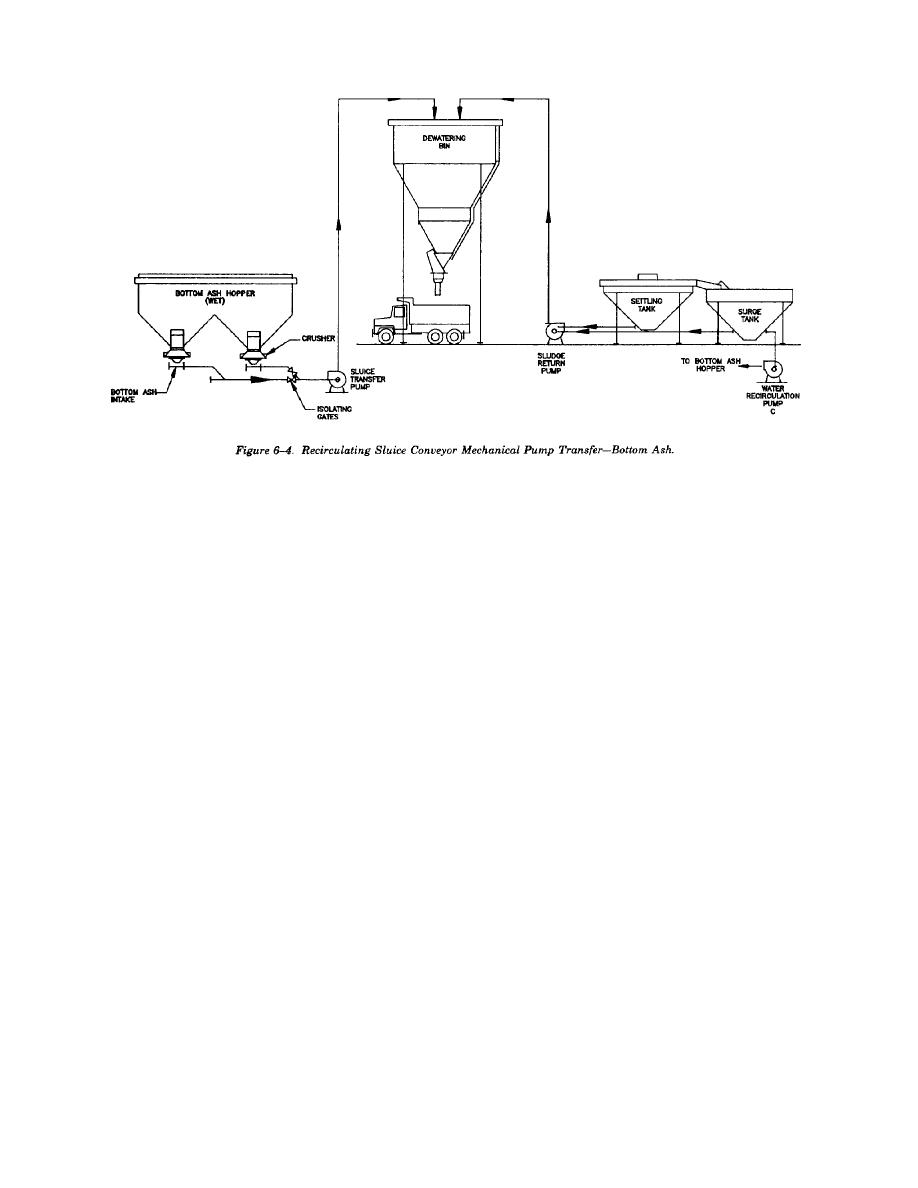
TM 5-810-15
ash is continuously removed by a submerged
6-5. Fly ash pneumatic systems.
scraper conveyor. The ash is then conveyed to
a. Pneumatic systems. This type of system is
either a storage bin with a capacity of up to three
usually used to transport fly ash from the fly ash
days or to a bunker for front end loader/truck
collection equipment storage hoppers to the ash
removal. The water is recirculated into and out of
storage silo. The tendency of some types of fly ash
the submerged trough to maintain a temperature
to form scale inside hydraulic fly ash conveying
below 140 degrees F. Overflow water from the
lines and its extremely slow settling rate in water
trough is filtered through tanks before it is recir-
when coupled with the environmental liquid dis-
culated into the system. Surge tanks are small
charge limitations have severely restricted the use
compared to the dewatering system tanks.
of the wet type fly ash conveying system. An
b. Sizing. The submerged scraper conveyor must
advantage of pneumatic systems is they can be
be sized so that the rate of ash removal will be at
applied to both fly ash and bottom ash for stoker
least as great as ash production at maximum
fired or fluidized bed boilers simplifying ash con-
continuous boiler steam output rating under worst
veying and storage as shown in figure 6-5. Pneu-
fuel conditions. Mechanical transport has several
matic systems are either vacuum or pressure types
advantages over hydraulic transport. The ash re-
of system. A vacuum system pulls ash from the fly
moved is dewatered, it requires a lower boiler
ash storage hoppers by means of mechanical, steam
setting height and reduces power and water con-
or water powered exhausters and a filtering system.
sumption. However, ash storage in a submerged
Vacuum systems, depending on capacity
scraper conveyor is limited and maintenance must
requirements, line configuration and plant altitude
be done in a relatively short period of time.
may be designed for vacuum levels ranging from 8
Expensive standby conveyors and transition hop-
to 20 inches Mercury (Hg). Vacuum systems are
pers are often needed to provide time to perform
generally preferable to pressure systems because
maintenance. The submerged scraper conveyor is
the system piping joint leaks pull air into the system
not commonly used in the United States because
leaving a cleaner environment. A vacuum system is
the reliability of the system in past years has been
recommended for capacities of less than 60 tph per
too low. There is some renewed interest by indus-
system. If the conveying distance is at a remote
try in the use of this type of system because of the
location of over 800 feet from the boiler plant an
recent improvements in the reliability and its wider
evaluation will be made to determine whether a
acceptance in the European countries. Also in
vacuum or pressure system is more feasible. A
current use in Europe is a continuous dry removal
comparison of vacuum systems and pressure
system utilizing moving stainless steel belting and
systems are shown in table 6-1.
introduction of additional air to complete
b. Pressure systems. A pressure system engages
combustion and cool the ash.
a positive displacement blower producing pressures
6-4


 Previous Page
Previous Page
